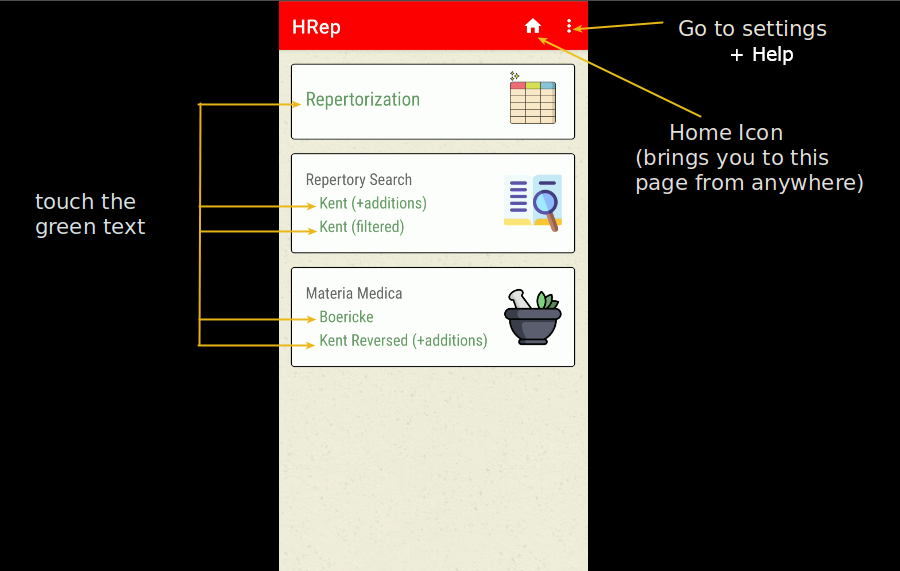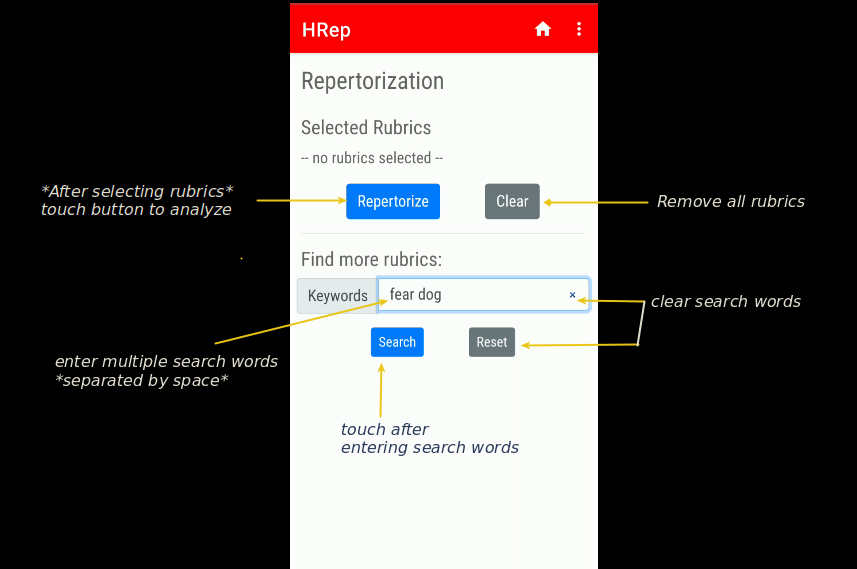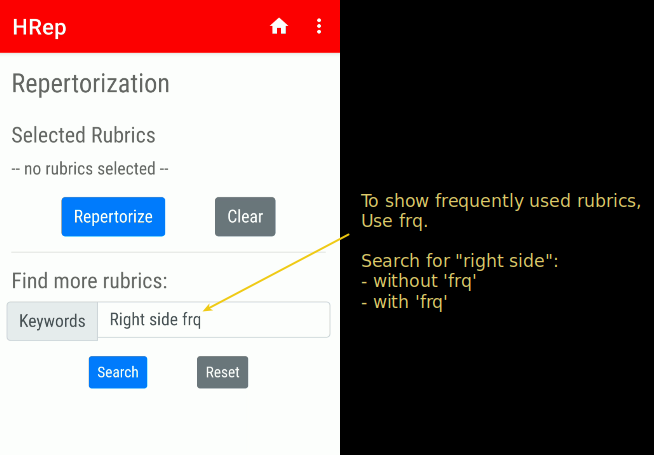HRep Help
Introduction
HRep is an Android App made for Homoeopaths - doctors and students. It is based on Kent's Repertory, with several additions from Boger Synoptic Key, Phatak's Repertory, Boericke's repertory, and also some prominent rubrics from newer repertories. It is completely free, with no Ads etc.
The app allows you to search Kent's repertory in several ways, as shown in this help file. It allows regular repertorization (classic) which counts the totality and grade. In addition, using some special rules we have built into the program, it outputs an "expert" analysis which gives different results if some drugs in the analysis contain keynotes. Further, we have linked the repertortorial analysis directly to materia medica, so you can confirm a drug immediately. You can consult Boericke's Materia Medica or Kent's repertory reversed.
There are several improvements that could be made to the app. Consistency in drug abbreviations is also something that needs more work. To take a simple example, we have calc-ars, nat-a, and aur-ar. This is simple enough to correct - and yet, it is just one of the dozens of things that vie for attention. Should we add more rubrics? Record more help videos? What about new drugs that are not in Kent's repertory - should they not be added first? What about drug classifications and drug relationships? And so on. Merely adding all rubrics from Boericke would take another six months, and we felt the app had reached a point where it could be useful if released now.
The plan is to do these things over time. However, given the constraints of time, we cannot give any assurance.
How to Use
The easiest way to learn and use HRep is by watching the help videos. Together, the five videos take only about 15 mins to watch. If you don't watch them, you may never learn how to use HRep to its full potential. Watch each video twice. In 30 mins, you will have the most powerful tools of HRep available for ready use.
Help Videos:
- Overview [2:08 mins]
- Repertory Search [4:16 mins]
- Repertorization [2:59 mins]
- Materia Medica [1:49 mins]
- New Features in HRep 1.1 [5:15 mins]
Overview

Search Boxes & Buttons

Quick Tip

Quick FAQs
These are frequently asked questions, so even before you read about how to use the App, please read these.
1. When we select rubrics for repertorization, why are the drugs not displayed for each rubric?
It is important not to be biased when selecting the rubric. There may be a desire to choose rubrics which have the drug we already feel is suitable for the case. Simply choose the rubrics that are most appropriate.
2. Why are only few drugs shown in the repertory analysis?
The top 12 drugs are shown. We felt there is little benefit in showing the 30th drug in the analysis.
3. Why are ranking counts/marks not displayed in the repertory analysis?
Because the correct prescription may fall in any of the top 12 remedies - and sometimes even outside. You should not look at 6/12 and say this is better than 4/11 (total number of rubrics/ grade total). Imagine this is a plant identification program. Just because the first one got 6/12, you don't conclude it is a Rose. You must match the picture, and then you might see that it is a cactus... pink colored, with thorns and petals etc. Always go to the materia medica and look up the top drugs.
4. How can we save the repertory analysis?
Cases can be saved once the repertory analysis is complete. Go to the menu (...) and touch "Print this page". You can then either print the PDF file, or save it with the patient name. By default it is saved in the "Downloads" folder on your phone. But you can created a HRep folder and save all files there.
5. Why are unrelated rubrics showing when I search for "ear pain"?
The program searches for text within the rubric. "ear" will also find "fear" and "appear". To get an exact match, type it as "ear,_pain" (the underscore character "_" is put in place of a space. Every comma, sequence of word must be exact. Another search tool is the "%" sign. Try "gener%night" or "pain%lying%ear" (no spaces before or after % sign). Experiment with these searches to understand properly.
6. Can classification or rubrics from pocket repertory be used in repertorization?
A. Yes. However, ensure that the similar rubrics are not repeated. If you take "thirstless" from pocket repertory and also from KentRep, the same drugs like gels, ipec may get counted twice for totality, grade etc. The same is true if you take a rubric and its subrubric with the same drug. e.g. "Teeth, pain" and "Teeth, pain, night, agg." will cause some of the same drugs to repeat.
Repertorization
The process of repertorization is as follows:
- Search for rubrics using the key search words.
- Touch search to see all relevant rubrics.
- Once you have selected the rubrics, you can click Repertorize.
- At least two rubrics need to be selected.
- If the rubrics don't have even one drug in common, no output will be shown.
Other important points to note:
- Search for one or more words with a space in between. Do not put any comma, dot or quotation marks etc.
- All search words need to be present in the rubric.
- Spelling errors will result in no output.
- Select and deselect the rubrics (✔) with a touch.
- Add the rubrics to be repertorized.
- You can continue to select and add more rubrics and then repertorize.
- Results are shown in two columns. The left column shows all drugs from output. The right column shows only small drugs.
- The top 12 drugs of the analysis are displayed in order of ranking, highest first.
- If you click on any drug in the results, you can go directly to the Materia Medica.
- You can use the special search word "frq" to see frequently used rubrics. This will limit and restrict the number of rubrics found, so use it carefully.
- "trp" is a special search word similar to "frq". It is to be used as a therapeutic search. In a patient with vomiting, after you have selected your rubrics, type in "vomit trp" in the search box to see other important rubrics you may wish to add. The key word "trp" is available for cough, fever, vomiting, vertigo and diarrhea as of now. For headache, search using "head trp". If you search Gels in the materia medica with "head trp" as the search words, you will understand the use of this feature.
- Note that all words with oe, ae etc have been simplified. So Diarrhoea = Diarrhea, Haemorrhoids = hemorrhoids. Words like aphthae remain as they are. Look at the rubrics in the Materia Medica (Kent Rep reversed) for some 3-4 drugs to understand.
- Grades are as in Kent's repertory - bold is gr 3, italics is gr 2 and normal is gr 1. Keynotes are indicated by a dark brown color - independent of grade.
Repertory Search
KentRep (+additions) consists of Kent's Repertory with several drugs and rubrics added - e.g. carcin, anhal etc. Many rubrics have been added from Phatak's repertory. Look at "direction", "complaints" etc in the search to see some of these. KentRep (filtered) contains these additions but it will not display any polychrests. This helps in focusing on the smaller drugs (approx less than 600-700 rubrics).
- Search the repertory using keywords found in Kent's Repertory. For this, you need a knowledge of the the repertory language.
- The sort order is alphabetical, but we have created a sort by relevance... if you choose it, keynotes and grade 3 rubrics come at the top.
- Materia Medica format is an option which will display drug-rubric combinations - for drugs which have all the search words.
- Searching without any keywords is usually a bad idea. If there are too many rubrics, a message will be displayed asking you to input some search criteria.
- Search words are persistent for a session. As long as you don't clear/reset or exit the app, the words will remain in search box for reuse.
- You can use the special search word "frq" in the text box to see frequently used rubrics. This will limit and restrict the number of rubrics found, so use it carefully. Experiment using frq - both in Repertory search as well as Materia Medica search.
- "trp" is a special search word similar to "frq". It is to be used as a therapeutic search. The key word "trp" is available for cough, fever, vomiting, vertigo and diarrhea as of now. For headache, search using "head trp". If you search Gels in the materia medica with "head trp" as the search words, you will understand the use of this feature.
- Note that all words with oe, ae etc have been simplified. So Diarrhoea = Diarrhea, Haemorrhoids = hemorrhoids. Words like aphthae remain as they are. Look at the rubrics in the Materia Medica (Kent Rep reversed) for some 3-4 drugs to understand.
- You can clear the search textbox by clicking on the [×] at the end of the box.
Materia Medica
- Boericke and Kent's Repertory reversed are the two Materia Medicas available.
- In Boericke's Materia Medica, drug names and their common names are indicated at the top, followed by Clarke's Clinical Indications.
- Start typing the abbreviation to see what remedies are available. It's safer to select the remedy to avoid typos.
- In Kent reversed (not Boericke) , you can further refine the search using keywords.
- In Kent reversed, at the end of each rubric you can see the number of drugs present in that rubric in brackets, e.g. fear of dogs [12].
- When you choose the display option "relevance", it will show keynotes and grade 3 rubrics for the drug first.
- In Boericke, the Modalities section has been moved to the top, immediately after Generalities.
- Frequently used rubrics are marked with (frq), so you could choose "bell" and enter frq in the searchbox (with or without other search words).
Special Keywords: frq, trp, pkr & classification
There are some special keywords which are present in rubrics to help focus the search. They can be used both while repertorizing as well as searching the materia medica. frq indicates rubrics that we frequently encounter in patients. trp represents rubrics that form the therapeutic indications in a specific condition. For example, you may have "head, pain, temple, left, eating after". Like this, there are thousands of specific rubrics which one may never encounter in the clinic. Much more common in headaches are - pain when going out in the sun, or from fasting etc. Such rubrics are marked with trp. A few rubrics are marked both trp and frq. Usually, frq represents more general symptoms - which can even be directly asked when thinking of / confirming a prescription. e.g. you think of Sulphur, look at Sulph in Kent's Repertory Reversed, used frq in search --> relevance view.
When you search for "head, pain" or "abdomen, pain" in Kent's Repertory, you will find more than 150 drugs for each of these, which is not very useful. We have added all rubrics from our custom "Pocket Repertory" which was included in our earlier app HQR. This allows you to use the special keyword pkr (for pocket repertory) in a search. When you search "pkr head", you get headache with 23 drugs. In some situations, this may be much more useful. You could use the rubric just as a reference/lookup, or even add it to your repertorization.
Another keyword is classification, which is a classification of all the drugs. For example, simply type "classification" in the Repertory Search to see the complete list. Or search for "classification carbon". If you want to look up the classification for a particular drug, go to the Materia Medica, Kent Reversed , select the drug name and search for "classification". e.g., puls and "classification" will give you Ranunculaceae.
Experiment with and without these special keywords to understand how they work. For example, try searching "stomach desire" and compare it with "stomach desire frq". In the first search, it will show you all food cravings that are present in HRep, including desire for lard, boiled milk, clean rags, etc.! The special keyword "frq" is especially useful when searching the Materia Medica for a specific drug.